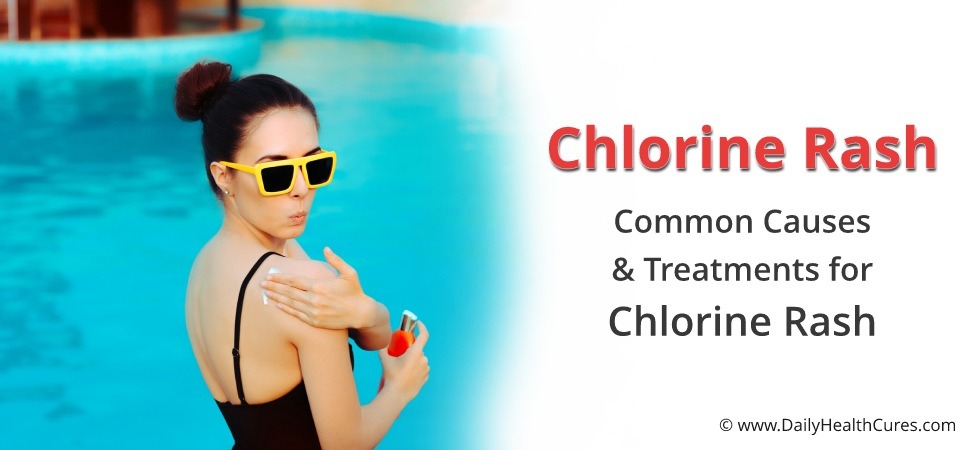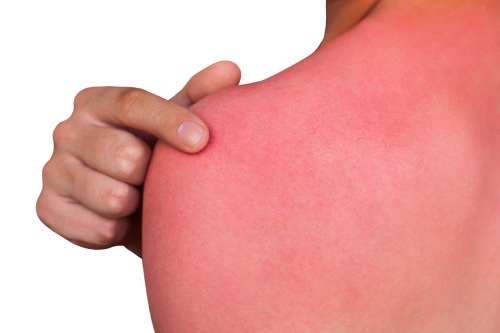How to Treat Chlorine Rash?

Chlorine is added to the pool water as it’s a strong oxidant properties and acts as a disinfectant. However, prolonged exposure to the chlorine in water can cause chlorine rash.
Swimming is one of the best exercises for people with asthma and allergies. But the pool water is stagnant, which makes it home to a lot of bacteria in it. Chlorine is often added to pool water. Chlorine because of its strong oxidant properties acts as a disinfectant.
Chlorinating pool water makes it sterile for bathing. But chlorine is also a harsh chemical. If present in high concentrations, its prolonged exposure might cause a dermatological reaction or chlorine rash.
Chlorine rash appears within hours of exposure to chlorine. It may present itself as a rash with itchy skin, or small clustered bumps after swimming. Because of hypersensitivity, chlorine rash is irritant dermatitis (simila to a chemical burn) and not an allergy.
The irritant may harm your sensitive respiratory tissues. Studies state frequent exposure to chlorinated products or pool water may increase the risk of asthma or other respiratory diseases in adults.
Causes of Chlorine Rash
Exposure to chlorine is the common cause of chlorine rash. But it’s not the only cause. The other causes that may lead to chlorine rash include:
- Staying in swimming pool for long hours
- Frequent relaxation in hot tub
- Regular visits to recreational water parks
- Working in a chlorine industry
- Working in bleaching industry
- Cleaning swimming pools
- Exposre to chlorine in water treatment industry
- Breathing and respiratory issues
- High use of cleansers or insecticides
There are many more causes of chlorine rash. If you are sensitive to chlorine then do pay attention, and find alternatives to work around it.
Chemical like chlorine does not get easily washed away from the hair and skin. For this reason, chlorine continues to irritate even after you have come out of the swimming pool. Use concentrated pH balance Vitamin C spray to help you out of it.
What Does Chlorine Rash Look Like?
 Reaction to chlorine leaves the skin appearing red. You may notice bumps on the skin, and itchiness or hives. It may also irritate your eyes and make them swell.
Reaction to chlorine leaves the skin appearing red. You may notice bumps on the skin, and itchiness or hives. It may also irritate your eyes and make them swell.
Prolonged exposure to highly chlorinated water can make the skin burn, cause blisters, or ulcerations. It may also damage the respiratory tract.
Some may experience severe problems even with the little exposure. While others can be unaffected.
The rashes reduce and become bearable as the exposure to chlorine diminishes.
Signs and Symptoms of Chlorine Rash
The symptoms and signs of the chlorine intolerance are as follows:
- Crusty or dry skin
- Bumps or hives on the skin
- Tenderness to touch
- Redness on skin
- Extreme itchiness
- Hair follicles full of pus
- Eye irritation, or swelling, redness, tearing, and vision problem
- Trouble breathing
- Whistling sound
- Noticeable body pain in affected body parts
- Irritated patches swell
- The affected skin area will peel in the end
- Allergies like fever, irritation of the airways, and inflammation of the bronchi
- Chest pain, respiratory issues that need immediate treatment
- Digestive problems such as abdominal cramps, vomit, along with a burning sensation
- Wheezing, swelling of the airways, lung disease, and contact dermatitis
Coughing and sneezing are common. They tend to restrict the foreign particles from entering into the respiratory tract.
Treatment of Chlorine Rash
There is always a solution to any problem and so is to chlorine rash. The best preventive alternative is to avoid swimming pools, water parks, or hot water as much as you can. And if not, keep your contact limited.
Also you should avoid sharing towel and clothes of the infected person. Here are some remedies or treatments that you should follow:
1. Cream and Ointments
Cream and ointment will always be helpful in improving the the rashes.
Creams contain corticosteroids that will help you to fetch quick results. It will erode your pain, itching, and inflammation. Do not use any cream or medicine until a doctor prescribes it for you.
2. Anti-bacterial Soap
It is crucial to keep the affected areas clean and dry at all times. Wash the irritated skin with anti-bacterial soap. It will help you avoid further spread of any bacterial infection.
3. Aloe Vera
Aloe Vera is a highly recommended natural treatment. It is rich in anti-inflammatory, antiseptic, antimicrobial, aesthetic, and anti-bacterial properties.
Aloe Vera soothes out any itchiness and redness that you may have and promotes healing. The best thing about aloe vera is that you can apply this gel directly to your rashes.
It will give you immense relief. Aloe vera is a natural remedy for many treatments, and chlorine rash is one of them.
4. Warm or Cold Compress
Chlorine rashes are painful and itchy, and cause skin redness. To ease these symptoms, you can use warm or cold compress method on the affected parts of the body.
For this, put ice cubes in the towel and then press it against the skin for more than 8 to 10 minutes. Then apply the ointment as per the prescription. Avoid any exposure to chlorine, until completely healed.
5. Starch Bath
Starch bath merely is water and corn-starch mixture. Use it as a remedy for scratching, which tends to exaggerate the infection. Starch bath is the best alternative to subside itchiness, redness, and pain.
Related Reading: 10 Health Benefits of Baking Soda Bath
6. Tea Tree Oil
Tea tree oil is a good remedy for chlorine oriented issues. Apart from killing the inductive bacteria it also heals the redness and itchiness. Tea tree oil is full of antimicrobial properties.
It has been successful in destroying bacteria and treating skin discomforts. The oil contains many active ingredients. It affects specific cells of immune system suppressing the production of inflammatory bacteria.
Apart from remedies mentioned above, there are many anti-inflammatory medicines available these days. Anti-histamines help with an allergic reaction.
Several other eye medications ease out swelling, itchiness, and redness. Vinegar and almond oil are also beneficial.Just don’t forget to take a bath after or before coming in contact with chlorine.
Related Reading: 10 Essential Oils for Cough or Cold and How to Use them
Prevention of Chlorine Rash
Chlorine rash is certainly not an end of your swimming sessions.
You only need to find the right precaution measures to prevent its harmful effects. Here are the few solutions to help you keep following your passion without any hurdles:
- Take a shower before and after swimming
- When going to a public pool, check the pH balance of the water. Submerge your feet in the water and wait for a while. If rashes don’t appear, then the pool is safe for swimming.
- Don’t hesitate to ask the manager about the level of chemicals in the pool.
- Remove your swimsuit immediately after swimming.
- There are various skin products that you can use to prevent rashes. You can apply lotion before and after swimming, as recommended by your doctor.
- Apply vitamin C spray to prevent skin irritation.
If you have your pool, then be specific while dissolving the exact amount of chlorine in the water. Too much of it is harmful. The ideal chlorine level is 1.0-3.0 ppm.
- Make it a habit of rinsing after swimming. Use anti-bacterial soap to clean your skin
- Ensure your swimming suit isn’t too tight
- Wash your swimsuit after using it
- Try buying the pool strips to check the pH balance as well as the chlorine level of the pool
Conclusion
Skin is the first layer of defense for your body. Being the topmost layer exposes it to various harmful external factors. It’s your foremost duty to protect it.
If you have sensitive skin, then you are at higher risk of running into skin related problems. If you get a chlorine rash, home remedies can come to your rescue. But if it doesn’t relieve the rash then consult your physician.
Sources:
“Chlorine Rash,” Health Tool web site, https://healthool.com/chlorine-rash/, last accessed Dec 16, 2017.
“Chlorine Rash,” Mddk Online Medical Doctor web site; https://mddk.com/chlorine-rash.html, last accessed Dec 16, 2017.
“Chlorine Rash,” Doctor Decides web site; https://doctordecides.com/chlorine-rash/, last accessed Dec 16, 2017.
“Chlorine Allergy,” Association College of Allergy, Asthama and Immunology web site; http://acaai.org/allergies/types/allergy-myths/chlorine-allergy, last accessed Dec 16, 2017.
